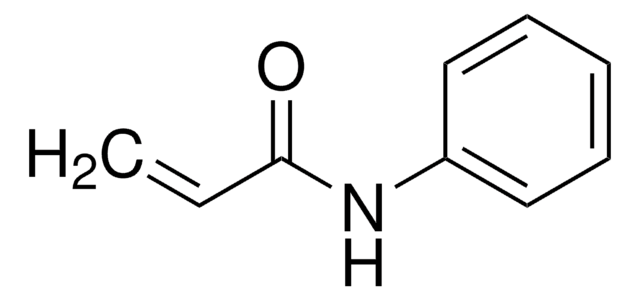790567
2-Tetrahydropyranyl acrylate
contains <500 ppm inhibitor, ≥97%
Synonym(s):
2-Propenoic acid tetrahydro-2H-pyran-2-yl ester, THPA
Sign Into View Organizational & Contract Pricing
All Photos(1)
About This Item
Empirical Formula (Hill Notation):
C8H12O3
CAS Number:
Molecular Weight:
156.18
MDL number:
UNSPSC Code:
12162002
PubChem Substance ID:
NACRES:
NA.23
Recommended Products
Assay
≥97%
form
liquid
contains
<500 ppm inhibitor
refractive index
n20/D 1.457
density
1.05 g/mL at 25 °C (lit.)
storage temp.
2-8°C
SMILES string
C=CC(OC1OCCCC1)=O
InChI
1S/C8H12O3/c1-2-7(9)11-8-5-3-4-6-10-8/h2,8H,1,3-6H2
InChI key
FGWRVVZMNXRWDQ-UHFFFAOYSA-N
Application
This acrylate is commonly used in the formation of photoresists, but can also be used as a protected acrylic acid.
Choose from one of the most recent versions:
Certificates of Analysis (COA)
Lot/Batch Number
Don't see the Right Version?
If you require a particular version, you can look up a specific certificate by the Lot or Batch number.
Already Own This Product?
Find documentation for the products that you have recently purchased in the Document Library.
Customers Also Viewed
Petzetakis; N.;
PMSE Preprints (2011)
Mattia Sanna et al.
Tobacco control, 29(1), 36-42 (2018-11-07)
Adult smoking prevalence in Taiwan rapidly declined from 26.5% in 2005 to 20.0% in 2015. Nevertheless, future projections on smoking-attributable deaths and current per capita consumption do not paint an equally bright picture. We used SimSmoke, a tobacco control simulation
Jiaxin Liu et al.
Cancer cell international, 20, 342-342 (2020-08-04)
Aberrant methylation and miRNA-target-gene regulation function as important mechanisms for gene inactivation in colon carcinogenesis. Although a serious of molecular events (such as aberrant alterations of genomics and epigenetics) have been identified to be related to prognostic in colon cancer
Ignacio Lacalle et al.
Sensors (Basel, Switzerland), 20(15) (2020-07-30)
During the past few decades, the combination of flourishing maritime commerce and urban population increases has made port-cities face several challenges. Smart Port-Cities of the future will take advantage of the newest IoT technologies to tackle those challenges in a
Our team of scientists has experience in all areas of research including Life Science, Material Science, Chemical Synthesis, Chromatography, Analytical and many others.
Contact Technical Service










